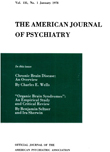FOLLOW-UP REPORT ON A SERIES OF POSTTRAUMATIC EPILEPTICS
Abstract
In spite of the irregular anticonvulsant therapy 55.5% of the patients originally discharged as controlled for at least 4 months have been free from seizures for from 12 to 18 months (Table 1). Approximately 20% have had only one attack. This response to anticonvulsant medication is quite encouraging, indicating that about three-fourths of the patients considered controlled medically maintained their healthy state.[SEE TABLE 1 IN SOURCE PDF]
In the group of medical failures some 40 cases were subjected to surgical removal of an epileptogenic focus. The remaining 26 cases serve as a control group for the surgical treatment. Approximately one year after operation one-third of the cases treated by cortical excision have had no further attacks and another fifth have had only one attack or the aura of their attacks. In the control group only 3 patients of 20 have had one or no attacks, and there is doubt of the reliability of the report on one of the cases.
The ultimate value of the surgical treatment of posttraumatic epilepsy can only be determined after a 5-or 10-year follow-up. There seems some reason to believe, however, that cortical excisions may offer help to a certain group of patients not benefited by medical management. With greater experience [see Table 2 in the Source PDF] and more precise knowledge of cortical physiology in focal epileptic states, surgical therapy may be of even greater value.
However, the posttraumatic epileptic has more social than medical difficulties. Economic and social rehabilitation is a primary need of these patients. Only when the posttraumatic epileptic is a useful member of society can the problem of posttraumatic epilepsy be considered solved.
Access content
To read the fulltext, please use one of the options below to sign in or purchase access.- Personal login
- Institutional Login
- Sign in via OpenAthens
- Register for access
-
Please login/register if you wish to pair your device and check access availability.
Not a subscriber?
PsychiatryOnline subscription options offer access to the DSM-5 library, books, journals, CME, and patient resources. This all-in-one virtual library provides psychiatrists and mental health professionals with key resources for diagnosis, treatment, research, and professional development.
Need more help? PsychiatryOnline Customer Service may be reached by emailing [email protected] or by calling 800-368-5777 (in the U.S.) or 703-907-7322 (outside the U.S.).



